2008 Seat Ibiza 5D snow chains
[x] Cancel search: snow chainsPage 66 of 260

Cockpit
64•
The tyre structure is damaged.
•
The vehicle is unbalanced because of a load.
•
The wheels of one axle are under more pressure (for example, driving with
a trailer or on extreme slopes).
•
The vehicle is fitted with snow chains.
•
The emergency wheel is fitted.
•
The wheel on one axle is changed.
Tyre pressure adjustment
Following the modification to tyre pressure or changing one or more wheels,
the button ⇒ page 63, fig. 37 must be kept pressed while the ignition is on
until an acoustic signal is heard.
If the wheels are under excessive load (for example, driving with a trailer or
heavy load), the tyre pressure must be increased to the recommended value
for a full load (see the sticker on the inside of the fuel flap). If the tyre monitor
system button is pressed down, the new tyre pressures are confirmed.
The tyre pressure monitor indicator
lights up
If the tyre pressure of one wheel is much lower than the value set by the
driver, then the indicator lights up ⇒.
WARNING
•
When the tyre pressure indicator l ights, reduce speed immediately and
avoid any sudden manoeuvre or braking. Stop when possible, and check
the tyre pressure and status.
•
The driver is responsible for maintaining correct tyre pressures. For this
reason, tyre pressures must be regularly checked.
•
Under certain circumstances (for example, when driving in a sportslike
manner, in winter conditions or on a dirt track) the tyre monitor indicator
may light up or function incorrectly.
Note
If the battery is disconnected, the yellow indicator
lights up after the igni-
tion is switched on. This should go out after a brief journey.
Speed selector lever lock*
The footbrake must be depressed when this warning lamp lights up. This is
necessary when the automatic gearbox* selector lever is moved out of posi-
tions P or N.Fuel level / reserve
This symbol lights up to indicate that the fuel tank under the
reserve level.It lights up when only 7 litres of fuel remain in the tank. Moreover, an audible
warning* is heard. It reminds you to fuel up the fuel tank as soon as possible
⇒ page 178.Indicates that the doors are open*
This indicator lights if one of th e doors or the tailgate is open.The warning light
should go off when all the doors are closed correctly.
Ibiza250_angles Seite 64 Dienstag, 5. August 2008 1:11 13
Page 147 of 260

Driving145
Safety First
Operating instructions
Practical tips
Te c h n i c a l D a t a
Caution
•
Please note that low obstacles detected by the system may no longer be
registered by the sensors as the car moves closer, so the system will not give
any further warning. Certain kinds of ob stacles (such as wire fences, chains,
thin posts or trailer draw bars, high kerbs or painted railings etc) may not
always be detected by the system, so there is a risk of damaging the vehicle
in such cases.
•
In some cases, obstacles with uniform edges and bumps may not be
detected immediately by the system due to their geometry. Take special care
with these types of obstacle, e.g. corners, recta ngular objects, etc.., these
can cause damage to the vehicle.
•
Be especially careful when manoeuvr ing into a corner between two
perpendicular walls. Survey the approach of the wall to the side of the vehicle
(using the mirrors)
•
The parking aid system does not replace use of the mirrors for manoeu-
vres.
•
Distant ultra-sonic sources (hammers, tyres, construction machinery,
other vehicles with PDC) may interfere with the operation of the system.
•
During the periodic cleaning of the sensors, take care not to damage or
scratch them. When cleaning with high pressure washers or steam cleaners,
the sensors should be sprayed for only a very short period and from a
distance of more than 10 cm.
Cruise control system (CCS)*Description
The cruise control system is able to maintain the set speed in
the range from approx. 30 km/h to 180 km/h.Once the speed setting has been saved, you may take your foot off the accel-
erator.
WARNING
It could be dangerous to use the cruise control system if it is not possible
to drive at constant speed.•
For safety reasons the cruise control system should not be used in
dense traffic, in sections with bends or where roads are in bad conditions
(e.g. aquaplanning, loose chippings, slippery surfaces, snow). Risk of acci-
dent.
•
Always switch the CCS off when finish to use it in order to avoid an
involuntary use.
•
It is dangerous to use a set speed which is too high for the current road,
traffic or weather conditions. Risk of accident.Note
The cruise control cannot maintain a constant speed when descending down-
hills. The vehicle will accelerate due to its own weight. Use the foot brake to
slow the vehicle.
Ibiza250_angles Seite 145 Dienstag, 5. August 2008 1:11 13
Page 153 of 260

Intelligent technology151
Safety First
Operating instructions
Practical tips
Te c h n i c a l D a t a
stances, when the slipping of the wheels is required, can they be discon-
nected with the ESP button, for example.
•
With compact temporary spare wheel.
•
When using the snow chains.
•
When driving in deep snow or on loose surfaces
•
When the vehicle is bogged-down, to free it by “rocking.”
The TCS should be switched on again afterwards as soon as possible.
WARNING
•
It must be remembered that TCS cann ot defy the laws of physics. This
should be kept in mind, particular ly on slippery and wet roads and when
towing a trailer.
•
Always adapt your driving style to suit the condition of the roads and
the traffic situation. Do not let the extra safety afforded by TCS tempt you
into taking any risks when driving, this can cause accidents.Caution
•
In order to ensure that TCS function correctly, all four wheels must be
fitted with the same tyres. Any differences in the rolling radius of the tyres can
cause the system to reduce engine power when this is not desired.
•
Modifications to the vehicle (e.g. to the engine, the brake system, running
gear or any components affecting the wh eels and tyres) could affect the effi-
ciency of the ABS and TCS.
Electronic stabilisation programme (ESP)*General notes
The electronic stabilisation programme increases the
vehic l
e ' s stability on the road.The electronic stabilisation programme helps to reduce the danger of skid-
ding.
The electronic stabilisation programme (ESP) consists of ABS, EDL and TCS.
Electronic Stabilising Program (ESP)*
ESP reduces the danger of skidding by braking the wheels individually.
The system uses the steering wheel angle and road speed to calculate the
changes of direction desired by the driver, and constantly compares them
with the actual behaviour of the vehi cle. If the desired course is not being
maintained (for instance, if the car is starting to skid), then the ESP compen-
sates automatically by braking the appropriate wheel.
The forces acting on the braked wheel bring the vehicle back to a stable
condition. If the vehicle tends to oversteer, the system will act on the front
wheel on the outside of the turn.
WARNING
•
It must be remembered that ESP cann ot defy the laws of physics. This
should be kept in mind, particularly on slippery and wet roads and when
towing a trailer.
•
Always adapt your driving style to suit the condition of the roads and
the traffic situation. Do not let the extra safety afforded by ESP tempt you
into taking any risks when driving, this can cause accidents.
Ibiza250_angles Seite 151 Dienstag, 5. August 2008 1:11 13
Page 204 of 260
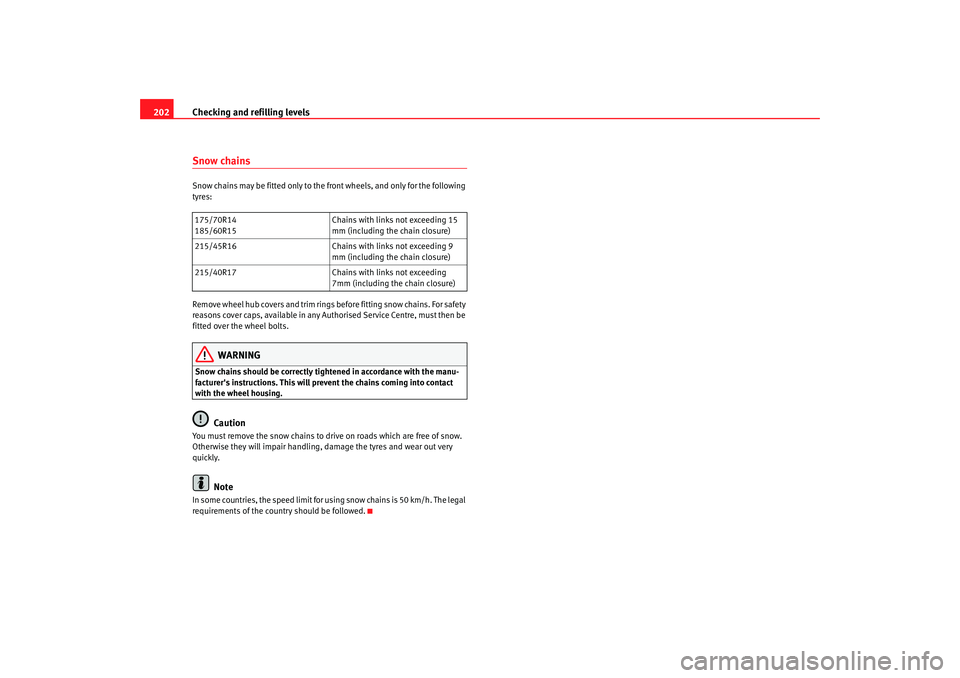
Checking and refilling levels
202Snow chainsSnow chains may be fitted only to the front wheels, and only for the following
tyres:
Remove wheel hub covers and trim rings before fitting snow chains. For safety
reasons cover caps, available in any Authorised Service Centre, must then be
fitted over the wheel bolts.
WARNING
Snow chains should be correctly tightened in accordance with the manu-
facturer's instructions. This will pr event the chains coming into contact
with the wheel housing.
Caution
You must remove the snow chains to drive on roads which are free of snow.
Otherwise they will impair handling, damage the tyres and wear out very
quickly.
Note
In some countries, the speed limit for using snow chains is 50 km/h. The legal
requirements of the country should be followed. 175/70R14
185/60R15
Chains with links not exceeding 15
mm (including the chain closure)
215/45R16 Chains with links not exceeding 9
mm (including the chain closure)
215/40R17 Chains with links not exceeding
7mm (including the chain closure)
Ibiza250_angles Seite 202 Dienstag, 5. August 2008 1:11 13
Page 206 of 260
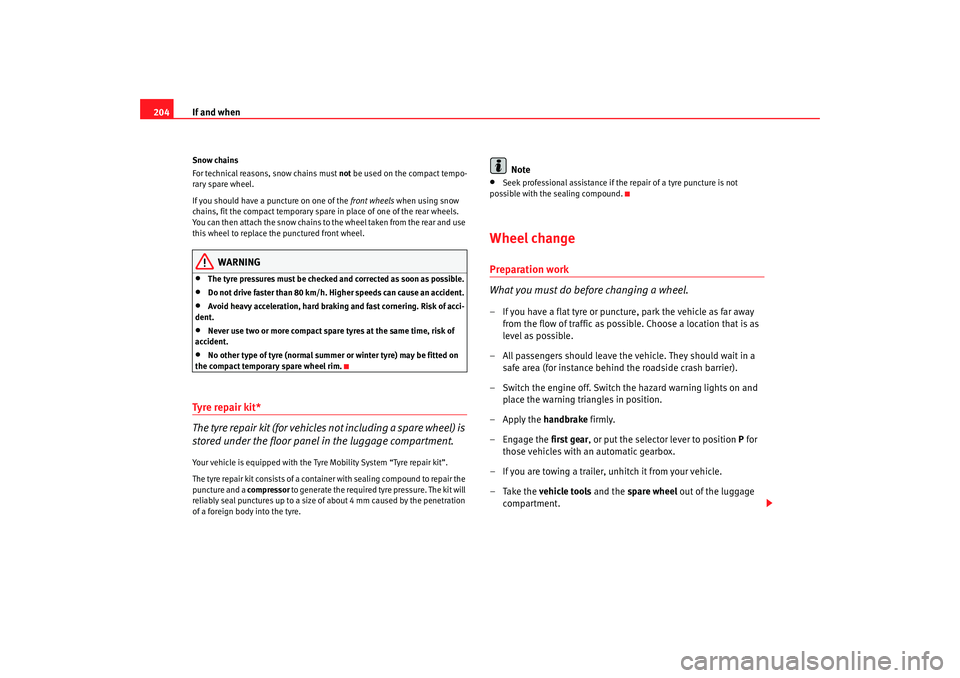
If and when
204Snow chains
For technical reasons, snow chains must not be used on the compact tempo-
rary spare wheel.
If you should have a puncture on one of the front wheels when using snow
chains, fit the compact temporary spare in place of one of the rear wheels.
You can then attach the snow chains to the wheel taken from the rear and use
this wheel to replace the punctured front wheel.
WARNING
•
The tyre pressures must be checked and corrected as soon as possible.
•
Do not drive faster than 80 km/h. Hi gher speeds can cause an accident.
•
Avoid heavy acceleration, hard braking and fast cornering. Risk of acci-
dent.
•
Never use two or more compact spare tyres at the same time, risk of
accident.
•
No other type of tyre (normal summer or winter tyre) may be fitted on
the compact temporary spare wheel rim.
Tyre repair kit*
The tyre repair kit (for vehicles not including a spare wheel) is
stored under the floor panel in the luggage compartment.Your vehicle is equipped with the Tyre Mobility System “Tyre repair kit”.
The tyre repair kit consists of a container with sealing compound to repair the
puncture and a compressor to generate the required tyre pressure. The kit will
reliably seal punctures up to a size of about 4 mm caused by the penetration
of a foreign body into the tyre.
Note
•
Seek professional assistance if the repair of a tyre puncture is not
possible with the sealing compound.
Wheel changePreparation work
What you must do before changing a wheel.– If you have a flat tyre or puncture, park the vehicle as far away from the flow of traffic as possible. Choose a location that is as
level as possible.
– All passengers should leave the vehicle. They should wait in a
safe area (for instance behind the roadside crash barrier).
– Switch the engine off. Switch the hazard warning lights on and place the warning triangles in position.
–Apply the handbrake firmly.
– Engage the first gear, or put the selector lever to position P for
those vehicles with an automatic gearbox.
– If you are towing a trailer, unhitch it from your vehicle.
–Take the vehicle tools and the spare wheel out of the luggage
compartment.
Ibiza250_angles Seite 204 Dienstag, 5. August 2008 1:11 13
Page 238 of 260
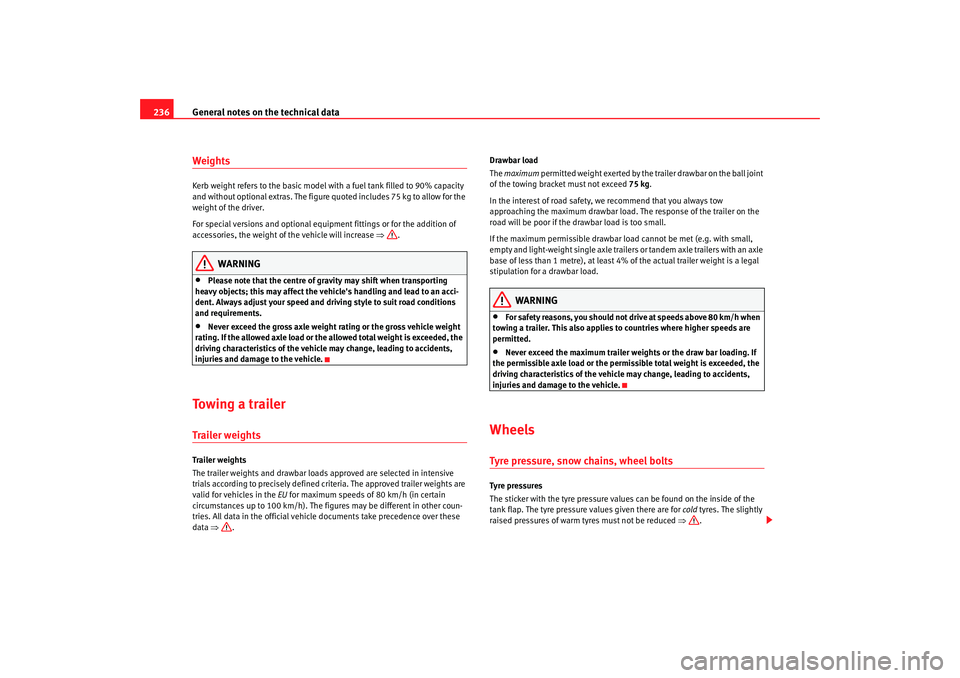
General notes on the technical data
236WeightsKerb weight refers to the basic model with a fuel tank filled to 90% capacity
and without optional extras. The figure quoted includes 75 kg to allow for the
weight of the driver.
For special versions and optional equipment fittings or for the addition of
accessories, the weight of the vehicle will increase ⇒.
WARNING
•
Please note that the centre of gravity may shift when transporting
heavy objects; this may affect the vehi cle's handling and lead to an acci-
dent. Always adjust your speed and dr iving style to suit road conditions
and requirements.
•
Never exceed the gross axle weight rating or the gross vehicle weight
rating. If the allowed axle load or the allowed total weight is exceeded, the
driving characteristics of the vehicle may change, leading to accidents,
injuries and damage to the vehicle.
To w i n g a t r a i l e rTrailer weightsTrailer weights
The trailer weights and drawbar loads approved are selected in intensive
trials according to precisely defined criteria. The approved trailer weights are
valid for vehicles in the EU for maximum speeds of 80 km/h (in certain
circumstances up to 100 km/h). The figu res may be different in other coun-
tries. All data in the official vehicl e documents take precedence over these
data ⇒ . Drawbar load
The
maximum permitted weight exerted by the trailer drawbar on the ball joint
of the towing bracket must not exceed 75 kg.
In the interest of road safety, we recommend that you always tow
approaching the maximum drawbar load. The response of the trailer on the
road will be poor if th e drawbar load is too small.
If the maximum permissible drawbar load cannot be met (e.g. with small,
empty and light-weight single axle trailers or tandem axle trailers with an axle
base of less than 1 metre), at least 4% of the actual trailer weight is a legal
stipulation for a drawbar load.
WARNING
•
For safety reasons, you should not drive at speeds above 80 km/h when
towing a trailer. This also applies to countries where higher speeds are
permitted.
•
Never exceed the maximum trailer weights or the draw bar loading. If
the permissible axle load or the perm issible total weight is exceeded, the
driving characteristics of the vehicle may change, leading to accidents,
injuries and damage to the vehicle.
WheelsTyre pressure, snow chains, wheel boltsTyre pressures
The sticker with the tyre pressure values can be found on the inside of the
tank flap. The tyre pressure values given there are for cold tyres. The slightly
raised pressures of warm tyres must not be reduced ⇒.
Ibiza250_angles Seite 236 Dienstag, 5. August 2008 1:11 13
Page 239 of 260
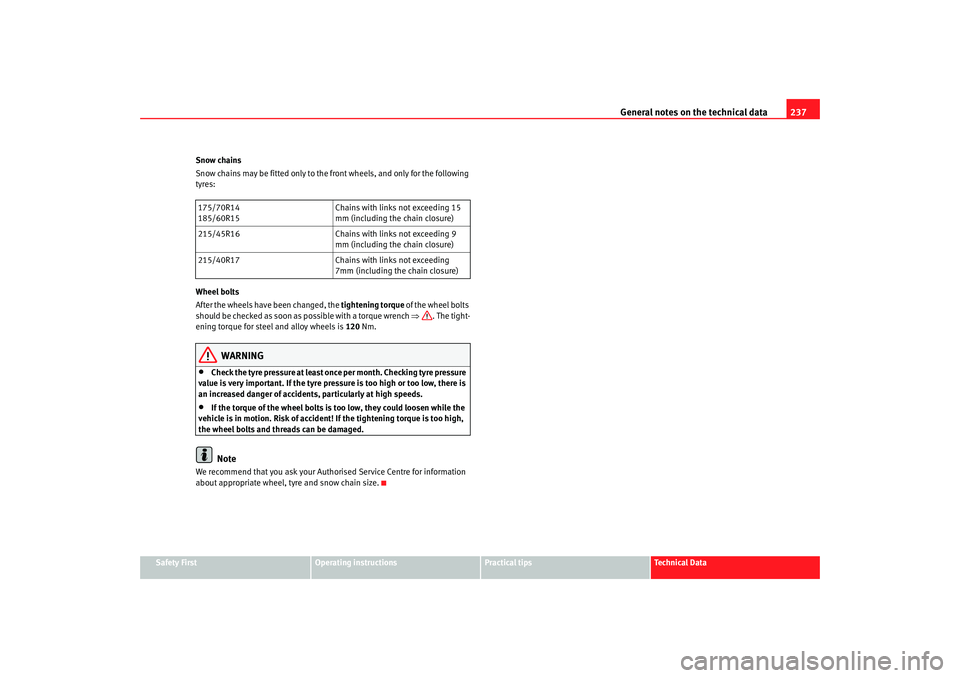
General notes on the technical data 237
Safety First
Operating instructions
Practical tips
Te c h n i c a l D a t a
Snow chains
Snow chains may be fitted only to the front wheels, and only for the following
tyres:
Wheel bolts
After the wheels have been changed, the
tightening torque of the wheel bolts
should be checked as soon as possible with a torque wrench ⇒. The tight-
ening torque for steel and alloy wheels is 120 Nm.
WARNING
•
Check the tyre pressure at least once per month. Checking tyre pressure
value is very important. If the tyre pre ssure is too high or too low, there is
an increased danger of accidents, particularly at high speeds.
•
If the torque of the wheel bolts is to o low, they could loosen while the
vehicle is in motion. Risk of accident! If the tightening torque is too high,
the wheel bolts and threads can be damaged.Note
We recommend that you ask your Authorised Service Centre for information
about appropriate wheel, tyre and snow chain size. 175/70R14
185/60R15
Chains with links not exceeding 15
mm (including the chain closure)
215/45R16 Chains with links not exceeding 9
mm (including the chain closure)
215/40R17 Chains with links not exceeding
7mm (including the chain closure)
Ibiza250_angles Seite 237 Dienstag, 5. August 2008 1:11 13
Page 256 of 260
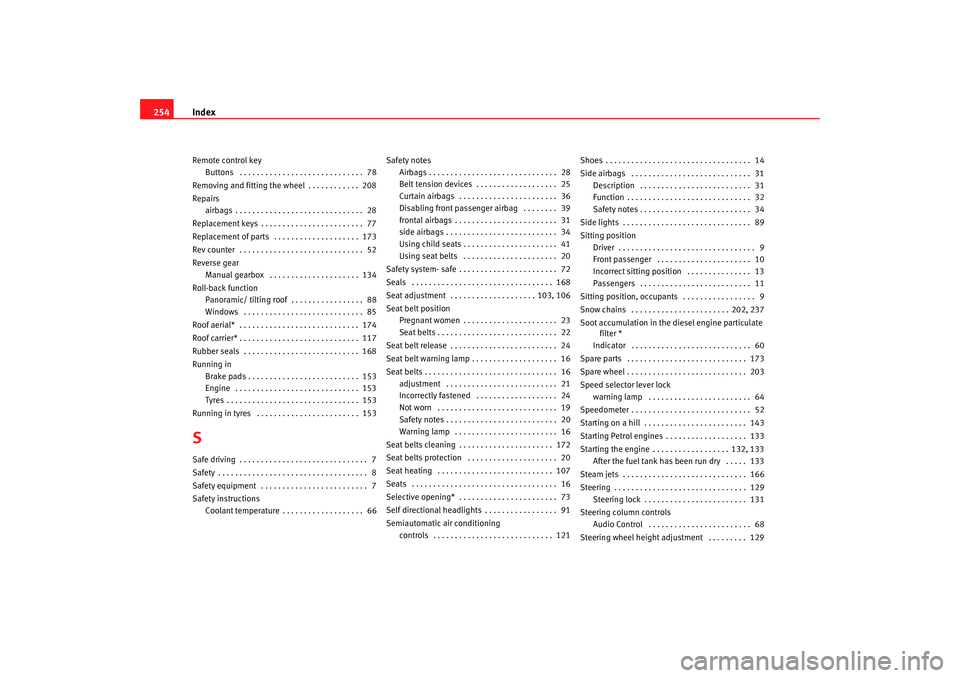
Index
254Remote control key
Buttons . . . . . . . . . . . . . . . . . . . . . . . . . . . . . 78
Removing and fitting the wheel . . . . . . . . . . . . 208
Repairs airbags . . . . . . . . . . . . . . . . . . . . . . . . . . . . . . 28
Replacement keys . . . . . . . . . . . . . . . . . . . . . . . . 77
Replacement of parts . . . . . . . . . . . . . . . . . . . . 173
Rev counter . . . . . . . . . . . . . . . . . . . . . . . . . . . . . 52
Reverse gear Manual gearbox . . . . . . . . . . . . . . . . . . . . . 134
Roll-back function Panoramic/ tilt ing roof . . . . . . . . . . . . . . . . . 88
Windows . . . . . . . . . . . . . . . . . . . . . . . . . . . . 85
Roof aerial* . . . . . . . . . . . . . . . . . . . . . . . . . . . . 174
Roof carrier* . . . . . . . . . . . . . . . . . . . . . . . . . . . . 117
Rubber seals . . . . . . . . . . . . . . . . . . . . . . . . . . . 168
Running in Brake pads . . . . . . . . . . . . . . . . . . . . . . . . . . 153
Engine . . . . . . . . . . . . . . . . . . . . . . . . . . . . . 153
Tyres . . . . . . . . . . . . . . . . . . . . . . . . . . . . . . . 153
Running in tyres . . . . . . . . . . . . . . . . . . . . . . . . 153SSafe driving . . . . . . . . . . . . . . . . . . . . . . . . . . . . . . 7
Safety . . . . . . . . . . . . . . . . . . . . . . . . . . . . . . . . . . . 8
Safety equipment . . . . . . . . . . . . . . . . . . . . . . . . . 7
Safety instructions Coolant temperature . . . . . . . . . . . . . . . . . . . 66 Safety notes
Airbags . . . . . . . . . . . . . . . . . . . . . . . . . . . . . . 28
Belt tension devices . . . . . . . . . . . . . . . . . . . 25
Curtain airbags . . . . . . . . . . . . . . . . . . . . . . . 36
Disabling front passenger airbag . . . . . . . . 39
frontal airbags . . . . . . . . . . . . . . . . . . . . . . . . 31
side airbags . . . . . . . . . . . . . . . . . . . . . . . . . . 34
Using child seats . . . . . . . . . . . . . . . . . . . . . . 41
Using seat belts . . . . . . . . . . . . . . . . . . . . . . 20
Safety system- safe . . . . . . . . . . . . . . . . . . . . . . . 72
Seals . . . . . . . . . . . . . . . . . . . . . . . . . . . . . . . . . 168
Seat adjustment . . . . . . . . . . . . . . . . . . . . 103, 106
Seat belt position Pregnant women . . . . . . . . . . . . . . . . . . . . . . 23
Seat belts . . . . . . . . . . . . . . . . . . . . . . . . . . . . 22
Seat belt release . . . . . . . . . . . . . . . . . . . . . . . . . 24
Seat belt warning lamp . . . . . . . . . . . . . . . . . . . . 16
Seat belts . . . . . . . . . . . . . . . . . . . . . . . . . . . . . . . 16 adjustment . . . . . . . . . . . . . . . . . . . . . . . . . . 21
Incorrectly fastened . . . . . . . . . . . . . . . . . . . 24
Not worn . . . . . . . . . . . . . . . . . . . . . . . . . . . . 19
Safety notes . . . . . . . . . . . . . . . . . . . . . . . . . . 20
Warning lamp . . . . . . . . . . . . . . . . . . . . . . . . 16
Seat belts cleaning . . . . . . . . . . . . . . . . . . . . . . 172
Seat belts protection . . . . . . . . . . . . . . . . . . . . . 20
Seat heating . . . . . . . . . . . . . . . . . . . . . . . . . . . 107
Seats . . . . . . . . . . . . . . . . . . . . . . . . . . . . . . . . . . 16
Selective opening* . . . . . . . . . . . . . . . . . . . . . . . 73
Self directional headlights . . . . . . . . . . . . . . . . . 91
Semiautomatic air conditioning controls . . . . . . . . . . . . . . . . . . . . . . . . . . . . 121 Shoes . . . . . . . . . . . . . . . . . . . . . . . . . . . . . . . . . . 14
Side airbags . . . . . . . . . . . . . . . . . . . . . . . . . . . . 31
Description . . . . . . . . . . . . . . . . . . . . . . . . . . 31
Function . . . . . . . . . . . . . . . . . . . . . . . . . . . . . 32
Safety notes . . . . . . . . . . . . . . . . . . . . . . . . . . 34
Side lights . . . . . . . . . . . . . . . . . . . . . . . . . . . . . . 89
Sitting position Driver . . . . . . . . . . . . . . . . . . . . . . . . . . . . . . . . 9
Front passenger . . . . . . . . . . . . . . . . . . . . . . 10
Incorrect sitting position . . . . . . . . . . . . . . . 13
Passengers . . . . . . . . . . . . . . . . . . . . . . . . . . 11
Sitting position, occupants . . . . . . . . . . . . . . . . . 9
Snow chains . . . . . . . . . . . . . . . . . . . . . . . 202, 237
Soot accumulation in the diesel engine particulate
filter *
Indicator . . . . . . . . . . . . . . . . . . . . . . . . . . . . 60
Spare parts . . . . . . . . . . . . . . . . . . . . . . . . . . . . 173
Spare wheel . . . . . . . . . . . . . . . . . . . . . . . . . . . . 203
Speed selector lever lock warning lamp . . . . . . . . . . . . . . . . . . . . . . . . 64
Speedometer . . . . . . . . . . . . . . . . . . . . . . . . . . . . 52
Starting on a hill . . . . . . . . . . . . . . . . . . . . . . . . 143
Starting Petrol engines . . . . . . . . . . . . . . . . . . . 133
Starting the engine . . . . . . . . . . . . . . . . . . 132, 133 After the fuel tank has been run dry . . . . . 133
Steam jets . . . . . . . . . . . . . . . . . . . . . . . . . . . . . 166
Steering . . . . . . . . . . . . . . . . . . . . . . . . . . . . . . . 129 Steering lock . . . . . . . . . . . . . . . . . . . . . . . . 131
Steering column controls Audio Control . . . . . . . . . . . . . . . . . . . . . . . . 68
Steering wheel height adjustment . . . . . . . . . 129
Ibiza250_angles Seite 254 Dienstag, 5. August 2008 1:11 13